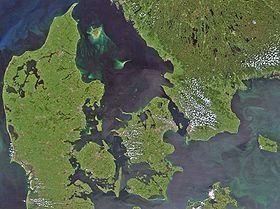 | ||
The Danish straits are the three channels connecting the Baltic Sea to the North Sea through the Kattegat and Skagerrak. They transect Denmark, and are not to be confused with the Denmark Strait between Greenland and Iceland. The three main passages are:
Contents
Map of Danish straits, Denmark
History
The Copenhagen Convention of 1857 made the Danish straits an international waterway.
Naming and geography
Specifically, there are five straits named 'belt' (Danish: bælt), the only ones in the world. Several straits are named 'sound' (Danish, Swedish and German: sund). Where an island is situated between a "belt" and a "sound", typically the broader strait is called "belt" and the more narrow one is the "sound":
Etymology of "sound" / "sund"
The Germanic word "sound" has the same root as the verb to sunder in the meaning of "to separate'". The Old Norse form of that verb is sundr. In Norway hundreds of narrow straits separating islands and combining fjords or outer parts of fjords are named "Sund".
Another explanation derives "sound" from an ancient verb "sund" in the meaning of to swim. That way a sound is a swimmable strait. In the Swedish language any strait is called "sund".
The Germanic word "sound" is not related to the Romance languages originated word "sound", which has developed from the Latin sonus.
